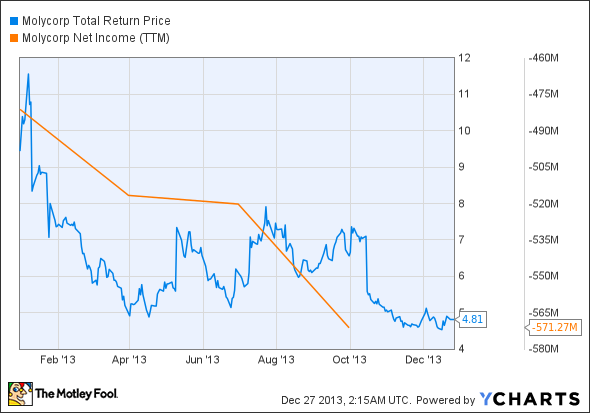It's been a rough year for Molycorp's (NYSE: MCP) investors. The year started with hope that increased production from its Mountain Pass mine would result in higher revenue, increasing profits, and a rising stock price. Instead, falling rare-earth prices have left the company's financial condition in shambles and the stock trading for a fraction of what it was a year ago.
MCP Total Return Price data by YCharts
Trouble is, there are still plenty of challenges facing Molycorp and the rest of the rare-earth industry.
Increasing supply
The hard truth in the rare earth mineral market is that these minerals aren't all that rare: They're found all over the world. It's just that there wasn't a lot of interest in developing them until China cut exports in 2010.
In North America, Molycorp has a large mine that could produce 40,000 metric tons of rare earths each year, while Rare Element Resources Ltd and Avalon Rare Metals Inc have early stage projects that could be built if the economics work out. Overseas, Australia's Lynas Corp has a mine and processing plant about half the size of Molycorp's, South Africa has major reserves it could develop, and now North Korea says it's planning to develop the world's largest deposit of rare earth minerals. And that's just scratching the surface of the places who have looked into exploiting their rare-earth assets.
To put these projects in context, China produced about 90-95% of the world's rare earths before Molycorp and Lynas began operations and this year capped production at 93,800 metric tons. So, these two companies alone have vastly increased global supply.
Not all of these projects contain the same amount of each rare earth mineral, but they all increase supply of the minerals they do contain. That's a problem because the rare-earth market is so small that a single plant's new capacity can throw supply and demand out of balance and crush prices, as Molycorp and Lynas have seen.
Falling prices
The imbalance of supply and demand in 2010 and 2011 drove climbing rare-earth prices, but the supply I mentioned above has crushed prices in the last two years. Unless demand increases exponentially (unlikely) or supply falls (more unlikely) prices will continue to come under pressure.
I don't see either happening and that means that margins will be constrained and net income will be tough to attain.
Shareholders own less and less
The bad year financially has meant that Molycorp didn't have the funds it needed to complete its plant expansion. Twice this year, the company went to the public markets, selling 43.1 shares in January and another 51.8 million shares in October . This nearly doubled the number of shares outstanding.
That should give Molycorp enough money to make it through 2014, but after that who knows? The company lost $177 million in the first three quarters of this year and burned through $90 million in operating cash, which doesn't including capital expenses.
A company that's burning cash in an oversupplied market is risky for investors and the only hope of survival is an increase in prices. Key minerals for Molycorp like lanthanum and cerium have seen prices fall even in the last few months, so a big improvement isn't in the cards anytime soon.
Foolish bottom line
Molycorp is a high risk for investors and I think the factors above make it a stock worth staying out of right now.






